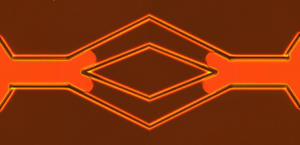Electrical control of defects in liquid crystals

Fast switching between liquid crystal (LC) states is an important factor in many applications of LC such as low latency displays. Researchers at Oxford have devised a method to lock-in polymeric LC profiles in photosensitive LC material, which accelerates the transition between high energy and low energy LC profiles compared to existing devices.
Liquid Crystal profiles lock-in though in-situ fabrication of polymeric structures by direct laser writing
Researchers at Oxford have developed a method to utilise direct laser writing (DLW), with in-built adaptive optics for aberration correction, for in-situ fabrication in polymerisable liquid crystalline (LC) devices. The ability to write in-situ permits the application of electric fields during fabrication that alters the macroscopic molecular configuration within the LC device.
Multidimensional polymer structures can thus be formed that mimic the LC profile at the instant of exposure to the ultrafast laser pulse in the DLW set-up. By writing at different electric field strengths, different LC states can be locked-in.
This method enables defects to be created, locked-in and then subsequently controlled with an electric field. The precise control of the defects enables new electro-optic behaviour to be discovered, fast-swithing states that are inherently unstable to be stabilised and microcargo such as microparticles to be transported from location of the device to another in a controlled way.
Applications include microfluidics-inspired devices as well as fast switching photonic devices.
Patent protection
A patent has been filed which covers this technology. Oxford University Innovation Ltd. is interested in talking to potential partners to aid in the commercialisation of this new method.
about this technology

